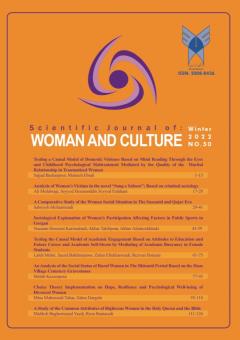بررسی صفات مشترک زنان صالح در قرآن کریم و کتاب مقدس
الموضوعات :
ملیحه باقری نژاد یزدی
1
![]() ,
رضا بنی اسدی
2
,
رضا بنی اسدی
2
1 - حوزه علمیه خواهران امام حسین (ع) یزد، گروه تفسیر قرآن کریم، یزد، ایران.
2 - دانشگاه علوم پزشکی شهید صدوقی یزد، گروه معارف اسلامی، یزد، ایران.
الکلمات المفتاحية: صفات زنان صالح, کتاب مقدس, قرآن کریم,
ملخص المقالة :
هدف از پژوهش حاضر تبیین صفات مشترک زنان صالحه در قرآن کریم و کتاب مقدس است. جامعه مورد بررسی آیات قرآن کریم و کتاب مقدس میباشد. نمونه پژوهش آیات الهی قرآن کریم و کتاب مقدس در رابطه با صفات مشترک زنان صالحه در قرآن کریم و کتاب مقدس است. این پژوهش توصیفی تحلیلی بوده و اطلاعات از طریق اسنادی و کتابخانهای حاصل شده است. تحلیل با استفاده از دادههای به دست آمده از آیات قرآن کریم و کتاب مقدس صورت گرفته است. نتایج پژوهش نشانداد که در قرآن کریم و کتاب مقدس برای زنان صالحه در دو حوزه فردی و خانوادگی صفاتی بیان شده است. از منظر قرآن کریم و کتاب مقدس زنان صالحه در حوزه فردی دارای صفاتی مانند ایمان، عمل صالح، تقواپیشگی، پاکدامنی، راستگویی، حیا، حجاب، پرهیز از خودنمایی و چشم پاکی میباشند. همچنین در حوزه خانوادگی زنان صالحه را دارای صفاتی مانند شوهرداری، خانهداری و فرزندپروری معرفی شدهاند.
The Holy Quran
Matthew Gospel
Old Testament
Afshar, L., & Rostami, Z. (2011). Characteristics of worthy women from the perspective of the Holy Quran. Quranic Studies, 2(5), 9-22. [Persian] URL: http://qsf.iranjournals.ir/article_629597_bd66bc5f8eb5ce2cfa2c27cb7b01e7ba.pdf
Ahmadi, M., & Hosseini Shahroudi, S. M., & Morvarid, J. (2021). Investigating the relationship between "faith" and "righteous deeds" with the focus on Quranic verses. Journal of Theology, 7(14),113-134. [Persian] URL: http://pke.journals.miu.ac.ir/article_5837_a1bf3c1127c2d238e3c4c25b36fc3240.pdf
Alikhani, R. (2010). Women in holy texts: women in Judaism. Tehran: Enlightenment and Women's Studies. [Persian] URL: https://www.gisoom.com/book/1732697/
Bakhtyiar, M., & Rezaee, A. (2012). Study of the status and position of women in Islam and Christianity. Women and Culture, 3(11), 61-73. [Persian] URL: http://jwc.iauahvaz.ac.ir/article_523297_a7da10d82681ab9176f3d6056bb8f8c8.pdf
Bokai M., & Enjazab, B. (2020). Marital lifestyle from the perspective of Islam. Article presented at the third national conference on lifestyle and health, Yazd, Iran. [Persian] URL: http://cnf.iauyazd.ac.ir/fa/article.php?lrId=59&cnfId=7
Chavoshiyan, M., & Nikoee, M. (2020). Study of the Status of Women in the Historical Periods of Christianity. Article presented at the Regional Conference on Applied Research in Humanities and Islamic Sciences, Gom, Iran. [Persian] URL: https://civilica.com/doc/1018557
Dashti Khoydaki, F., & Tabatabai, S. A., & Etemadi Fard, A. (2017). Women's duties in the family in imami jurisprudence. Article presented at the First National Conference on Social Sciences, Educational Sciences, Psychology and Social Security, Tehran, Iran. [Persian] URL: https://civilica.com/doc/672316
Farhadi, S., & Andalib, A. (2017). Hijab in the Quran and the Bible, International Journal of Multidisciplinary and Interreligious Pure Life, 1(8), 67-85. [Persian] URL: https://www.magiran.com/paper/1699272
Javadi Amoli, A. (2019). Woman in the mirror of glory and beauty. Qom: Esraa. [Persian] URL: https://library.tebyan.net/fa/Viewer/Text/61570/8#
Kamranian, A. (2009). Characteristics of Worthy Women in the Holy Quran. Qom: Noor Quran and Ahlul Bayt Publications. [Persian] URL: https://ahlolbait.com/files/download/12/3389-FA-vijegihaye-zanan-shayesteh-dar-quran-majid.pdf
Makarem Shirazi, N. (1992). Tafsir of Nemoneh. Tehran: Islamic Books House. [Persian] URL: https://lib.eshia.ir/27575/2/161
Moradi Khalaj, M. (2010). Righteous women in the Quran. Shiite Women, 7(23), 132-151. [Persian] URL: http://ensani.ir/file/download/article/20120614194814-9011-5.pdf
Najafi, Mohammad Hassa. (2001). Jawahar al-Kalam. Qom: Islamic Publishing Institute. [Persian] URL: http://lib.eshia.ir/10088/17/131
Oladi, Sh., & Jahanbakhsh, E., & Mohamadi, A. (2019). The effect of bad hijab and dressing on women's sense of personal security Case study: Women and girls over 15 years old in Tehran. Socio-disciplinary researches on women and the family, 7(1), 102-120. [Persian] URL: http://pssw.jrl.police.ir/article_91406_5e2ae9dca84ef924fb313c53e3b4b2d0.pdf
Panahi, A. (2016). A look at the benefits and effects of childbearing and parenting in religious teachings with a moral approach. Ethics, 6(21), 33-63. [Persian] URL: http://akhlagh.morsalat.ir/article_63976_f8a4fe7f994f02bc643e70acb2f860a1.pdf
Qaraati, M. (2009). Tafsir Noor. Tehran: Cultural Center for Lessons from the Quran. [Persian] URL: https://www.ghbook.ir/index.php?name=%D8%AA%D9%81%D8%B3%DB%8C%D8%B1%20%D9%86%D9%88%D8%B1&option=com_dbook&task=readonline&book_id=2665&page=1&chkhashk=18A0AD00E3&Itemid=218&lang=fa&tmpl=component
Riahi Dehkordi, P. (2018). A comparative study of female personality in the Holy Quran and the testaments. Article presented at the International Conference on Innovation and Research in Humanities, Management and Islamic Studies, Tehran, Iran. [Persian] URL: https://civilica.com/doc/800465
Sadati, E., & Naemati, D. (2015). The position of women in the West from the Bible to Descartes. Article presented at the Second International Congress of Religious Culture and Thought, Qom, Iran. [Persian] URL: https://civilica.com/doc/548243
Sakhaee, M. (2011). Finding the root of the women's crisis in the West by relying on biblical teachings. Strategic Studies of Women, 14(53), 247-274. [Persian] URL: http://www.jwss.ir/article_12241_c1c574fcbcc460de574602a5f6b75a00.pdf
Shakurinejad, E. (2014). Faith from the perspective of the Holy Quran and the New Testament. Esharat, 1(1), 106-122. [Persian] URL: http://ensani.ir/file/download/article/20141027110402-9965-6.pdf
Tabarsi, F. (1995). Tafsir of majma-albayan. Beirut: Al-Alamy Foundation for Publications. [Persian] URL: http://lib.eshia.ir/12023/1/2
Tabatabai, M. (1995). Tafsir of al-Mizan. Beirut: Al-Alamy Foundation for Publications. [Persian] URL:. [Persian] URL: https://archive.org/details/almizan_alami_22j//
_||_


